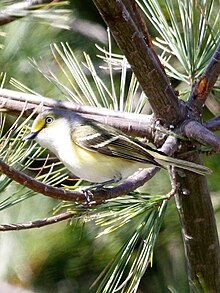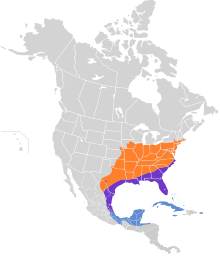White-eyed vireo
This article needs additional citations for verification. (December 2023) |
| White-eyed vireo Temporal range:
| |
|---|---|

| |
| Scientific classification | |
| Domain: | Eukaryota |
| Kingdom: | Animalia |
| Phylum: | Chordata |
| Class: | Aves |
| Order: | Passeriformes |
| Family: | Vireonidae |
| Genus: | Vireo |
| Species: | V. griseus
|
| Binomial name | |
| Vireo griseus (Boddaert, 1783)
| |

| |
The white-eyed vireo (Vireo griseus) is a small songbird of the family Vireonidae.
Distribution and habitat
It breeds in the eastern United States from
Breeding
The grass-lined nest is a neat cup shape, attached to a fork in a tree branch by
Description
Measurements:[2]
- Length: 4.3-5.1 in (11-13 cm)
- Weight: 0.3-0.5 oz (10-14 g)
- Wingspan: 6.7 in (17 cm)
Its head and back are a greyish olive, and the underparts are white with yellow flanks. The wings and tail are dark, and there are two white wing bars on each wing. The eyes have white irises, and are surrounded by yellow spectacles. Sexes are similar.
Call
The white-eyed vireo's song is a variable and rapid six to seven note phrase, starting and ending with a sharp chick.
Diet
During the breeding season, the diet of this species consists almost exclusively of insects, primarily caterpillars. In the autumn and winter it supplements its diet of insects with berries.
Taxonomy
The white-eyed vireo was described by the French polymath
Six subspecies are recognised:[9]
- V. g. griseus (Boddaert, 1783) – central and east US (includes noveboracensis)[11][12]
- V. g. maynardi Brewster, 1887 – south Florida (southeast US)
- V. g. bermudianus Bangs & Bradlee, 1901 – Bermuda
- V. g. micrus Nelson, 1899 – south Texas (south US) and northeast Mexico
- V. g. perquisitor Nelson, 1900 – east Mexico
- V. g. marshalli Phillips, AR, 1991 – east central Mexico
The northern subspecies, V. g. noveboracensis, occupies most of the range of this species and is fully migratory. This sub-species is larger and has more brightly colored plumage than all other subspecies.
The resident southeastern coastal plain race, V. g. griseus is a slightly smaller and duller colored subspecies. It does not typically migrate out of its breeding range in the winter.
The resident Florida Keys race, V. g. maynardi, is greyer above and whiter below, and the south Texan V. g. micrus is like a smaller maynardi.
V. g. bermudianus is endemic to
Gallery
-
White-eyed vireo (Vireo griseus) at Clarks River National Wildlife Refuge
-
White-eyed vireo
-
Vireo griseus bermudianus in Bermuda
-
White-eyed vireo (Vireo griseus bermudianus) in Bermuda
-
White-eyed vireo by Alastair Rae
References
- . Retrieved 20 October 2022.
- ^ "White-eyed Vireo Identification, All About Birds, Cornell Lab of Ornithology". www.allaboutbirds.org. Retrieved 2020-09-27.
- ^ Buffon, Georges-Louis Leclerc de (1780). "Le gris-olive". Histoire naturelle des oiseaux (in French). Vol. 7. Paris: De L'Imprimerie Royale. p. 392.
- Daubenton, Louis-Jean-Marie (1765–1783). "Tangara olive, de la Lousiane". Planches Enluminées D'Histoire Naturelle. Vol. 8. Paris: De L'Imprimerie Royale. Plate 714 Fig. 1.
- ^ Boddaert, Pieter (1783). Table des planches enluminéez d'histoire naturelle de M. D'Aubenton : avec les denominations de M.M. de Buffon, Brisson, Edwards, Linnaeus et Latham, precedé d'une notice des principaux ouvrages zoologiques enluminés (in French). Utrecht. p. 45, Number 714 Fig. 1.
- JSTOR 2421142.
- ^ Paynter, Raymond A. Jr, ed. (1968). Check-list of Birds of the World. Vol. 14. Cambridge, Massachusetts: Museum of Comparative Zoology. pp. 113–114.
- ^ Vieillot, Louis Pierre (1808). Histoire naturelle des oiseaux de l'Amérique Septentrionale : contenant un grand nombre d'espèces décrites ou figurées pour la première fois (in French). Vol. 1. Paris: Chez Desray. p. 83. The title page bears a date of 1807 but the volume did not appear until the following year.
- ^ a b Gill, Frank; Donsker, David, eds. (2019). "Shrikes, vireos, shrike-babblers". World Bird List Version 9.2. International Ornithologists' Union. Retrieved 24 August 2019.
- ISBN 978-1-4081-2501-4.
- ISBN 978-0-9568611-2-2.
- ^ Remsen, J.V. Jr.; Cardiff, S.W.; Dittmann, D.L. (1998). "Status and natural history of birds of Louisiana. I. Vireos (Vireonidae)" (PDF). Journal of Louisiana Ornithology. 4 (2): 59–102.
- ^ "Birds: White-eyed Vireo (Vireo griseus bermudianus)". Department of Environment and Natural Resources of the Government of Bermuda. Department of Environment and Natural Resources of the Government of Bermuda. Retrieved 2021-10-03.
- Audubon Society of Bermuda. Retrieved 2021-10-03.
External links
- Xeno-canto: audio recordings of the white-eyed vireo
- Bermuda Online: Bermudian Fauna
- Nature Conservation in Bermuda at Cave Biology.Com
- White-eyed Vireo Species Account - Cornell Lab of Ornithology
- Bird Banding at Caddo Lake (includes White-eyed Vireo photo)
- White-eyed Vireo Bird Sound at Florida Museum of Natural History
- Explore Species: White-eyed Vireo at eBird (Cornell Lab of Ornithology)
- White-eyed Vireo photo gallery at VIREO (Drexel University)
- White-eyed Vireo species account at Neotropical Birds (Cornell Lab of Ornithology)






